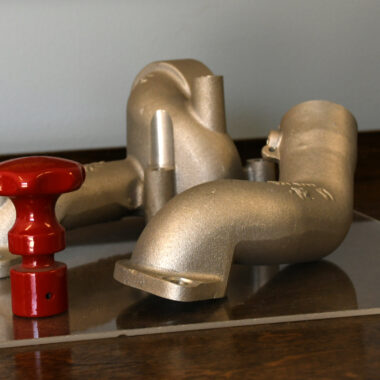Aluminum Spreading Solutions Introduced: Vital Insights and Tips
Discovering the realm of light weight aluminum casting solutions can reveal a globe of complex processes and nuanced factors to consider that are important for successful end results. As industries significantly turn to light weight aluminum for its lightweight yet durable residential or commercial properties, recognizing the essentials of casting comes to be critical. From the basic techniques to the complex information that can make or break a spreading project, there is a wide range of insights and pointers waiting to be found. As we venture right into the world of light weight aluminum spreading solutions, prepare to reveal the crucial components that can shape the trajectory of your jobs and boost your understanding of this intricate craft.
The Basics of Aluminum Casting
What fundamental procedures are entailed in light weight aluminum spreading that develop the foundation of this extensively used manufacturing technique? Aluminum casting is a functional and economical technique utilized in different markets to produce complicated and complex steel parts. The procedure starts with the melting of light weight aluminum ingots in a heating system, typically at temperature levels varying from 1220 ° F to 1670 ° F, relying on the certain aluminum alloy being used. Once molten, the light weight aluminum is put right into a pre-designed mold cavity, where it solidifies and takes the form of the mold.
After solidification, the mold and mildew is gotten rid of, and the casting undertakes completing processes such as heat surface, treatment, and machining finish to fulfill the required specifications. Understanding these essential procedures is important for accomplishing high-grade aluminum castings with precise dimensions and mechanical residential properties.
Various Casting Methods Described
Exploring the various strategies employed in aluminum spreading offers useful insights into the varied approaches utilized to accomplish intricate and accurate steel components. One usual technique is sand spreading, where a mold is produced making use of compacted sand around a pattern of the desired component. One more technique, pass away casting, includes injecting liquified aluminum right into a steel mold under high pressure.
Aspects to Think About When Selecting a copyright
When picking an aluminum casting company, evaluating their experience and knowledge is crucial for making sure top quality and reliability in the manufacturing process. The copyright's experience in the area shows their familiarity with different spreading techniques, prospective difficulties, and finest methods. It is vital to ask about the kinds of projects they have dealt with in the past, guaranteeing they straighten with the intricacy and specifications of your own job.
In addition, take into consideration the provider's reputation within the sector. Try to find testimonials, testimonials, and study that show their capability to deliver top notch light weight aluminum castings regularly. A trustworthy supplier will usually have qualifications or affiliations with industry companies, showcasing their commitment to excellence and adherence to market standards.
Moreover, assess the copyright's abilities in regards to personalization, volume demands, and project timelines. Make sure that they can accommodate your his comment is here specific demands and have the versatility to range production as needed. Effective communication and transparency regarding costs, lead times, and quality assurance procedures are likewise important aspects to think about when choosing an aluminum casting provider.

Typical Difficulties and Solutions
Browsing through the intricacies of aluminum casting procedures typically offers producers with a collection of challenges that need cutting-edge services to make certain effectiveness and top quality in production. One typical obstacle faced in light weight aluminum casting is the formation of issues such as porosity, shrinkage, or incorporations due to improper mold layout or insufficient steel quality.
An additional challenge hinges on attaining exact dimensional accuracy, particularly for intricate geometries. Variations in cooling prices, mold and mildew expansion, and product residential properties can cause variances from the intended dimensions. Carrying out innovative innovations like computer-aided design (CAD) and computer system numerical control (CNC) machining can boost precision and uniformity in light weight aluminum spreading. Furthermore, maintaining proper control over the melting and pouring procedures is crucial to avoid problems like getting too hot or irregular distribution of the molten steel - casting aluminum. By spending in automation and real-time surveillance systems, producers can improve process control and reduce variants, inevitably boosting the total quality of aluminum cast products.
Tips for Optimizing Your Casting Projects
By ensuring that Read Full Article the gating system is properly designed and effectively put, you can improve the flow of liquified light weight aluminum and minimize the possibilities of flaws in the final casting. In addition, making use of computer simulations can help in predicting and analyzing the flow of metal during the casting procedure, enabling for modifications to be made before actual production begins.

Final Thought
To conclude, understanding the essentials of aluminum casting, different casting approaches, factors to think about when selecting a service provider, common obstacles and remedies, and suggestions for optimizing casting tasks are essential for effective end results. By sticking to these understandings and carrying out ideal services, methods and individuals can ensure effective and efficient light weight aluminum spreading solutions that fulfill their specific needs and demands.
Comprehending these essential processes is necessary for attaining high-quality aluminum castings with mechanical buildings and specific measurements.
When choosing an aluminum casting solution provider, assessing their experience and experience is critical for ensuring quality and reliability in the manufacturing process. Effective communication and openness regarding prices, lead times, and top quality control procedures are likewise vital variables to take into consideration when selecting an aluminum spreading solution company.
Navigating via the intricacies of light weight aluminum spreading processes typically provides makers with a series of difficulties that call for ingenious options to make sure effectiveness and high quality in manufacturing. One typical obstacle encountered in light weight aluminum spreading is the formation of defects such as porosity, shrinking, or inclusions due to improper mold and mildew design or inadequate steel high quality.
Comments on “Expert Guide to Casting Aluminum : Strategies, Tips & Techniques”